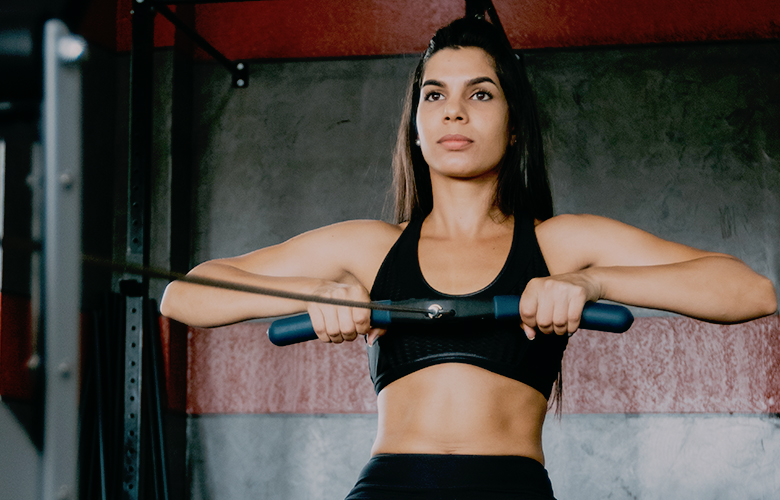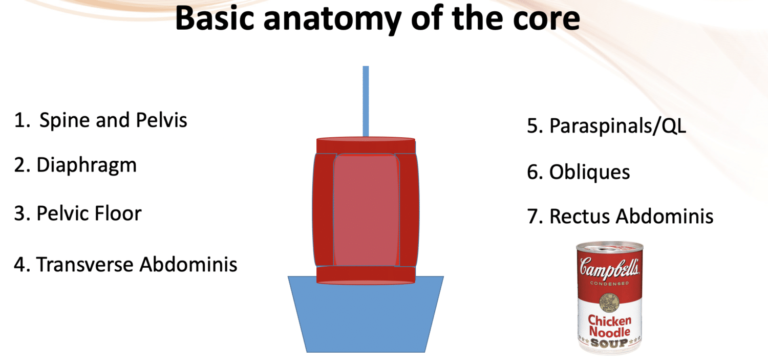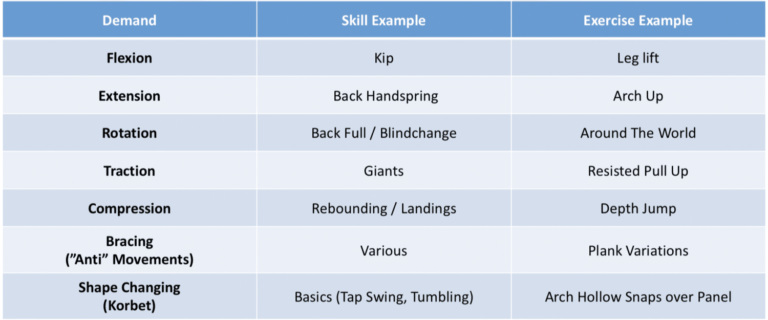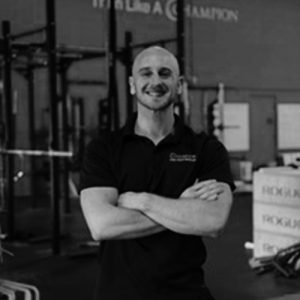
A strong, stable core is one of the absolute “must haves” in gymnastics. One reason is performance-based, as different events and the skills within those events require massive amounts of core strength. Creating “stiffness” in body shapes to absorb force allows good punching, lines, and handstand fundamentals.
It is also integrated during shape changes as seen with basic tap swings and tumbling. Lastly, a strong core allows for maximal force production to occur in the arms and legs, which is important for sprinting during vault, various leaps/jumps, and bar or ring events.
A second reason for developing core strength is more injury prevention related, as gymnastics places massive force on the spine of a gymnast. Peak vertical forces during simulated landing tasks reach up to 9x body weight in gymnastics (find a great research paper here), while maximal vertical forces during the take-off of a double back on the floor have been recorded at 6874 Newtons (reference here).
Spine injuries and back pain in gymnasts have been reported between 25% and 84% (more research within this journal volume here) and unfortunately are something that plague gymnasts during and after their competitive careers (more research here) causing limited skill progress and time away from training.
This is understandable, and I was this way for many years. The combination of the mysterious “core” being confusing to wrap your head around, social media giving 100s of exercises, and us only having so much time/equipment during practice all combine to make people really frustrated.
Many people are left asking:
To help people clear up the murky water, here are 3 principles that I have found absolutely essential. Because they are more principle-based, and not “the best exercise”, they can be adapted to any situation, athlete level, or context. Knowing these has allowed me to create many different core training programs for both athletes I coach and athletes I treat for back injuries.
You would never attempt to change the brakes on your car if you knew nothing about the wheels, brake pads, or axles. The same goes for core conditioning. You can’t hope to build a great core program if you don’t understand basic core function and anatomy, and then view them in the context of gymnastics demands.
I view the core as having three roles:
I have read a lot of spine injury research, as well as strength and conditioning textbooks, and from all of this, I like to picture the core as a “canister” of muscles surrounding the spine.

It has a larger outer layer with muscles like the obliques, rectus abdonimis, paraspinals, diaphragm, and pelvic floor. These work mostly under our control and can produce lots of power (we understand how to “flex our abs”). There is also a deeper layer full of very tiny muscles that only span 1 or 2 joints, that help automatically control these segments. These work more on autopilot (we can’t “flex our L2-L3 multifidi” as well) and require specific loads or movements to help recruit. Which leads to my next point.
Unfortunately, just doing lots of leg lifts and planks won’t optimally prepare a gymnast for the high force demands of gymnastics. Nor will it help prevent back pain. If that were the case, the injury rate would be staggeringly low. Most gymnasts are building core training into their weekly training through drills, skills, and separate core strength circuits.
It’s not that those things aren’t important, they just won’t train everything needed for success. Core “control” is also absolutely essential for gymnasts alongside core strength. Just like anything else in gymnastics, it must be valued as part of training while being done with the correct focus and technique.
In my mind, 3 components of understanding alignment, knowing how to brace using the entire core, and knowing how to breathe during this process make up the foundation of core control.

Various drills can be used to teach this, and done in warm-ups, as side stations, and during prehab or lighter days. When you combine these control aspects with good technique and gymnastics specific movements like leg lifts, presses, and hollow / arch holds we start to be on the right track. Which leads to number 3.
When creating core conditioning programs, we must understand that the gymnastics places a variety of demands on athletes. Here is a table I made that summarizes most in my mind, along with skill and exercise examples.

In order to prepare for this huge range of demands, programs must choose exercises that create movement (as is commonly seen in gymnastics specific conditioning with leg lifts, arch ups, or around the worlds) but also resist movement (as is commonly seen in gymnastics or regular fitness with planks, kettlebell carries, sled dragging).
This helps build a very robust core that can dynamically snap into shapes like during a double back, but also remain “stiff” under high forces occurring suddenly such as catching an overshoot handstand on bars.
We must prepare athletes for both of these categories, and in a variety of motions. I made a huge mistake in not understanding how all aspects, including the diaphragm on top, pelvic floor, and transverse abdominal, needed to be trained in the gym.
As a bonus, I wanted to build all these points together to really drive home my main point. Although in gymnastics we do see lots of isolated skill based movements (compression during kips, tight arch setting for tumbling), no one core muscle is ever working by itself.
Even in specific skill circumstances the core is working as a unit to produce, transfer, and absorb force. This is definitely the case during shape changing where the shoulders and hips also help. This is also seen during punching on floor, hitting the springboard on vault, and under massive forces during dismounts or landings. However for most of gymnastics, the core is working as a unit as mentioned above.
Due to this, we have to make sure we program exercises that not only support gymnastics specific creation of shapes but also exercises that teach the athlete how to brace for stiffness while keeping proper breathing patterns.
Nutrition, Mental Toughness And Recovery
Overcoming Failure: 3 Steps To Get Back On Track


Dave Tilley DPT, SCS, CSCS is a Physical Therapist who graduated in 2013 from Springfield College. Dave comes from an extensive gymnastics background, being a former athlete and currently still coaching optional level gymnastics in Boston. Dave was a competitive gymnast for 18 years, 4 of them collegiately as part of the Springfield College Men’s Team. Dave has also been coaching gymnastics for 12 years, being involved in beginner, national, and elite levels. His unique background as a former athlete and current coach gives him a one of a kind approach for the performance and rehabilitation of gymnasts. He has successfully treated some of the most talented high school, collegiate, and junior elite level gymnasts in the country. Along with gymnastics, Dave enjoys treating athletes of all sports as well as the specialized treatment of Olympic Weightlifters and CrossFit athletes. He has worked with regional and national level Olympic Weightlifters, as well as Regional and Games level CrossFit Athletes. Dave graduated from Springfield College with his Bachelors in Science, a Minor in Psychology, and Doctorate in Physical Therapy. He became Board Certified in Sports Physical Therapy in February of 2016, and became a Certified Strength and Conditioning Coach in 2017. His current interests include prevention and rehabilitation of extension based spine injuries, shoulder and hip instability, periodization and strength and conditioning models, as well as the science involved in long-term athletic development, mobility training, and motor control. He participates in ongoing continuing education by attending various courses, collaborating with other professionals, and staying up to date with the most current medical research. Along with treating in the clinic, Dave is also the CEO/Founder of “SHIFT Movement Science and Gymnastics Education”. This company was started in 2014 to help educate those involved in gymnastics, medical fields, Olympic weightlifting, CrossFit, and more about optimal performance and preventative rehabilitation strategies. By combining his roles as a healthcare provider, current coach, and athlete Dave looks to help remold the gymnastics world with current, scientifically backed principles that optimize a gymnast’s long-term potential. His new forward-thinking ideas have been nationally recognized with members of USA Gymnastics, being implemented into JO, Collegiate, and Elite level programs. Dave travels to speak both nationally and internationally at various events across the country including Make It Right Elite Gymnastics Camp, USAG Regional, and National Congress, Power Monkey Camp in Tennessee, and has consulted with many NCAA Division 1 Men’s and Women’s Gymnastics. Dave is very passionate about his work both in the clinic and gymnastics training arena. He aims to deliver the best possible care to the clients he sees and athletes he trains. He hopes to soon become more active in the role of conducting research studies related to gymnastics. Dave is the newest addition to the Champion Physical Therapy and Performance Team.
Read Full Profile© 2021 TheatreArtLife. All rights reserved.

Thank you so much for reading, but you have now reached your free article limit for this month.
Our contributors are currently writing more articles for you to enjoy.
To keep reading, all you have to do is become a subscriber and then you can read unlimited articles anytime.
Your investment will help us continue to ignite connections across the globe in live entertainment and build this community for industry professionals.